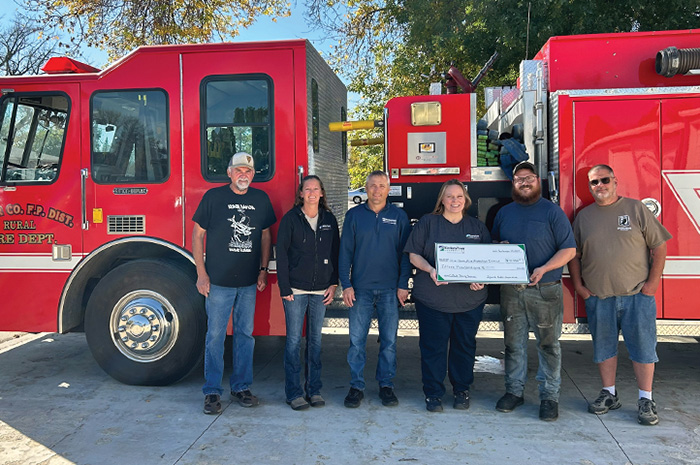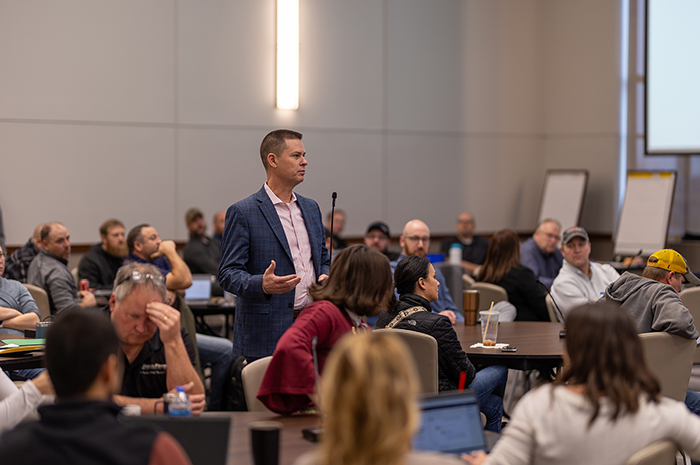Minnkota celebrates 80th anniversary
Join Minnkota Power Cooperative in reflecting on an eight-decade history of powering North Dakota and Minnesota.
Minnkota Power Cooperative will celebrate its 80th anniversary on March 28, 2020. To mark the milestone, we would like to share a brief look back at the cooperative’s history – its formation, its challenges and its industry-leading innovations.
A powerful idea
Minnkota Power Cooperative, Inc., was officially formed on March 28, 1940, but its story begins a year earlier in the small community of Whitman, N.D.

In 1939, the region’s farm families began forming rural electric cooperatives to receive the same centrally generated electricity that those living in cities and towns were already enjoying. However, the wholesale cost of power from regional investor-owned utilities was very costly. The frustrated men and women in rural Whitman turned to 30-year-old Andrew. L. Freeman to develop a solution.

Freeman, the new manager of the Five Star Rural Electric Cooperative at the time, traveled to the Rural Electrification Administration (REA) headquarters in Washington, D.C., to obtain a loan for a new power plant. REA officials told Freeman that his cooperative should fund and build its own plant. Freeman knew Five Star could not do so without REA support, so he fought until he secured a $40,000 loan for a 40-kilowatt (kW) diesel plant in Whitman.
The plant’s construction began in September 1939. Unfortunately, it was soon evident the plant wouldn’t be large enough to meet the regional need. Soon, other electric cooperatives joined Five Star to organize a regional generating plant – Walsh County Electric, Forks Electric and Traill County Electric. The four co-ops merged to create Nodak Rural Electric Cooperative and named Freeman as their manager. Nodak then joined five Minnesota cooperatives – PKM Electric Cooperative (Warren), Wild Rice Electric Cooperative (Mahnomen), Red Lake Electric Cooperative (Red Lake Falls), Red River Valley Cooperative Power Association (Halstad) and Itasca-Mantrap Electric Cooperative (Park Rapids).
As these systems joined forces, they understood they would need an areawide power supply plan to properly serve the area.
Minnkota’s beginnings
On March 28, 1940, the cooperatives gathered hundreds of farmers at the Grand Forks County Courthouse to explain their plan. The group voted to form Minnkota Power Cooperative with Freeman as manager. Construction of a Grand Forks power plant began in October 1940, and in September 1941, three 720-kW diesel generators and 165 miles of 34.5-kilovolt (kV) transmission line came online.

Progress was held up during World War II, but power became even more vital to the region when the war was done. Five more cooperatives joined Minnkota – Beltrami Electric Cooperative (Bemidji), Cass County Electric Cooperative (Kindred), Cavalier Rural Electric Cooperative (Langdon), Clearwater-Polk Electric Cooperative (Bagley) and Sheyenne Valley Electric Cooperative (Finley). Itasca-Mantrap left Minnkota in 1948.
Minnkota continued to grow, adding three more generators at the Grand Forks diesel plant and additional substations and transmission lines across the system. A diesel plant at Harwood, N.D., and a new Grand Forks lignite-fired steam plant also began construction. Peak demand was still rising, and Minnkota needed to stay ahead of the risk of power outages. Five more diesel generators began producing electricity in Grand Forks in 1949.

In 1955, the Garrison Dam – located on the Missouri River in central North Dakota – became another power source to the region. Power suppliers contracted for the dam’s electricity through the Western Area Power Administration (WAPA). That same year, Border Counties Power Cooperative in Warroad, Minn., reached out to Minnkota to work out a wholesale power agreement, and Border’s members – Roseau Electric Cooperative (Roseau) and North Star Electric Cooperative (Baudette) – joined Minnkota.
Lignite online
In 1966, the REA approved a $55.7 million loan for a mine-mouth lignite coal plant near Center, N.D. The Milton R. Young Station was named for the man who helped secure the plant’s future – Sen. Milton R. Young of North Dakota. A 230-kV transmission line from Center to Fargo was also included in the project plans.
The Young Station came online in November 1970. The innovative plant was designed to overcome the obstacles of using lignite coal and was nestled next to the man-made Nelson Lake for a steady supply of cooling water.

Square Butte Electric Cooperative was formed in 1972 by Minnkota’s 11 cooperatives and plans began for a second generating plant at the Young Station. Square Butte’s Young 2 was completed in May 1977 and included a 465-mile transmission line to Duluth, Minn.
Square Butte sells Young 2’s power to Minnkota and Minnesota Power of Duluth. Minnkota operates the 250-megawatt (MW) Young 1 and the 455-MW Young 2, which have ranked among the lowest-cost generators in the country.
Demand response
In the 1970s, the rising cost and unavailability of products like propane and fuel oil led many consumers to look to electricity for their heating needs. Minnkota and its members knew the increase in demand would necessitate a new power plant, which would be expensive and drive up the cost of the electricity. They needed another solution. Thus, Minnkota’s load management program (demand response) was rolled out in 1977.

The voluntary program allows Minnkota to remotely interrupt consumers’ electric heaters and other loads in exchange for a discounted retail electric rate, enabling Minnkota to better manage its existing power resources. Demand response is still popular today – about 50,000 consumers participate. The most common loads involved are dual-fuel heating systems, water heaters, storage heaters and commercial loads with backup generators. Minnkota has also added electric vehicle chargers to the program.
Municipal partnership
In the mid-1970s, several northwestern Minnesota and eastern North Dakota cities were collectively negotiating with Minnkota for additional power to meet their communities’ long-term needs. Twelve of those cities joined together in 1976 to form the Northern Municipal Power Agency (NMPA), a Minnesota political subdivision.
Around this time, Minnkota purchased a 30% ownership share in the new Coyote Station lignite coal plant. In 1981, Minnkota and its members created a Joint System that would allow NMPA to buy Minnkota’s share of the Coyote Station and leverage its ability to access lower-cost, tax-exempt financing.

The formation of the Joint System was Freeman’s final victory for Minnkota, as he retired at the end of 1982 after 42 years of management. Freeman gained fame for inventing the head-bolt engine heater and for several other economic development achievements. Minnkota executive Lyle Lund took over as manager in 1983 and served until retiring in 1990. David Loer became president & CEO in 1990.
Natural disasters strike
April 1997 delivered a one-two punch to Minnkota and its employees. First, a historic ice storm hit the Red River Valley, destroying power poles and a large portion of Minnkota’s transmission system. Minnkota employees worked long hours in the following days to restore power to around 50,000 people. The cost of restoration rose above $7 million.

Two weeks later, floodwaters from the Red River overcame Greater Grand Forks. Fifty thousand residents were forced to evacuate, including the majority of Minnkota's Grand Forks employees. Minnkota’s warehouse, diesel plant, main office building and Service Center 3 basement were all damaged – racking up $3.8 million in recovery costs.

New energy
As a new generation of power consumers gained interest in alternate forms of 21st-century energy, Minnkota and NMPA began plans for incorporating wind into the portfolio with the Infinity Wind Energy Program. In 2002, Minnkota commissioned the first commercial-scale, utility-owned wind turbine in North Dakota, located near Valley City. Later that year, another turbine was installed near Petersburg, N.D.
In the mid-2000s, Minnkota began working with NextEra Energy Resources and Otter Tail Power Company to build the Langdon Wind Energy Center near Langdon, N.D. The 133-turbine wind farm came online in January 2008. Later that year, Minnkota added more wind capacity from the Ashtabula Wind Energy Center near Valley City, N.D.
In 2017, Minnkota tapped into more wind in Oliver and Morton Counties in North Dakota. The Oliver III Wind Energy Center is a 44-turbine wind farm owned by NextEra affiliates.
Minnkota was recognized in 2010 by the U.S. Department of Energy as the Wind Energy Cooperative of the Year.

Power plant upgrades
From 2006 to 2011, Minnkota made substantial investments in the Young Station’s Unit 1 and Unit 2 generators. System improvements included upgrades to lower sulfur dioxide (SO2) and nitrogen oxides (NOx) emissions levels. Minnkota didn’t stop there. Efforts were made to substantially reduce mercury emissions in advance of new limits implemented in 2015.

Power for the future
Regional demand for electricity continued to grow in the early 2000s, so Minnkota and its partners began exploring solutions. A new power plant wasn’t feasible, so in 2009 Minnkota and Minnesota Power reached an agreement through which Minnkota would receive an increasing allocation of Young 2’s output. By 2026, Minnkota will purchase 100% of Young 2’s power.
Minnkota deemed it would need another high-voltage line to reliably deliver electricity from Young 2. In May 2012, construction began on a 250-mile, 345-kV transmission line from Center to Grand Forks. The $354 million project took 117 weeks to complete and became fully operational August 2014.

The past 10 years have been a decade of change for Minnkota. In December 2010, Minnkota hired Robert “Mac” McLennan as the cooperative’s fourth president and CEO. In 2015, the cooperative broke ground on a new Grand Forks headquarters. Completed in December 2017, the state-of-the-art facility allows employees to occupy a single building, work more efficiently and leverage advanced security.

At the onset of the 2020s, Minnkota engineers and crews have worked hard to fortify affordable, reliable power for our growing communities. Minnkota is in the midst of rebuilding many miles of power lines across the region, as well as upgrading and constructing new substations to meet demand.
Looking to the future, Minnkota has a bold plan for continuing baseload generation at the coal-fired Young Station in would could be carbon-managed world. Project Tundra is an initiative that would capture more than 90% of Unit 2’s carbon dioxide (CO2) emissions and store it safely and securely more than a mile underground. The project is currently in its final research and design phases. If the project moves forward, construction could begin in 2022.
...



